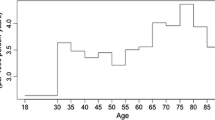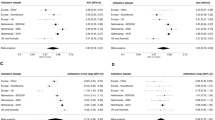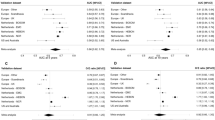Abstract
Purpose
Women diagnosed with unilateral breast cancer are increasingly choosing to remove their other unaffected breast through contralateral prophylactic mastectomy (CPM) to reduce the risk of contralateral breast cancer (CBC). Yet a large proportion of CPMs are believed to be medically unnecessary. Thus, there is a pressing need to educate patients effectively on their CBC risk. We had earlier developed a CBC risk prediction model called CBCRisk based on eight personal risk factors.
Methods
In this study, we validate CBCRisk on independent clinical data from the Johns Hopkins University (JH) and MD Anderson Cancer Center (MDA). Women whose first breast cancer diagnosis was either invasive and/or ductal carcinoma in situ and whose age at first diagnosis was between 18 and 88 years were included in the cohorts because CBCRisk was developed specifically for these women. A woman who develops CBC is called a case whereas a woman who does not is called a control. The cohort sizes are 6035 (with 117 CBC cases) for JH and 5185 (with 111 CBC cases) for MDA. We computed the relevant calibration and validation measures for 3- and 5-year risk predictions.
Results
We found that the model performs reasonably well for both cohorts. In particular, area under the receiver-operating characteristic curve for the two cohorts range from 0.61 to 0.65.
Conclusions
With this independent validation, CBCRisk can be used confidently in clinical settings for counseling BC patients by providing their individualized CBC risk. In turn, this may potentially help alleviate the rate of medically unnecessary CPMs.


Similar content being viewed by others
References
Tuttle TM, Habermann EB, Grund EH, Morris TJ, Virnig BA (2007) Increasing use of contralateral prophylactic mastectomy for breast cancer patients: a trend toward more aggressive surgical treatment. J Clin Oncol 25(33):5203–5209
Tuttle TM, Jarosek S, Habermann EB, Arrington A, Abraham A, Morris TJ, Virnig BA (2009) Increasing rates of contralateral prophylactic mastectomy among patients with ductal carcinoma in situ. J Clin Oncol 27(9):1362–1367
King TA, Sakr R, Patil S, Gurevich I, Stempel M, Sampson M, Morrow M (2011) Clinical management factors contribute to the decision for contralateral prophylactic mastectomy. J Clin Oncol 29(16):2158–2164
Wong SM, Freedman RA, Sagara Y, Aydogan F, Barry WT, Golshan M (2017) Growing use of contralateral prophylactic mastectomy despite no improvement in long-term survival for invasive breast cancer. Ann Surg 265(3):581–589
Nichols HB, Berrington de Gonzalez A, Lacey JV, Rosenberg PS, Anderson WF (2011) Declining incidence of contralateral breast cancer in the United States from 1975 to 2006. J Clin Oncol 29(12):1564–1569
Murphy JA, Milner TD, O’Donoghue JM (2013) Contralateral risk-reducing mastectomy in sporadic breast cancer. Lancet Oncol 14(7):e262–269
Abbott A, Rueth N, Pappas-Varco S, Kuntz K, Kerr E, Tuttle T (2011) Perceptions of contralateral breast cancer: an overestimation of risk. Ann Surg Oncol 18(11):3129–3136
Metcalfe KA, Narod SA (2002) Breast cancer risk perception among women who have undergone prophylactic bilateral mastectomy. J Natl Cancer Inst 94(20):1564–1569
Khan SA (2011) Contralateral prophylactic mastectomy: what do we know and what do our patients know? J Clin Oncol 29(16):2132–2135
Chowdhury M, Euhus D, Onega T, Biswas S, Choudhary PK (2017) A model for individualized risk prediction of contralateral breast cancer. Breast Cancer Res Treat 161:153–160. https://doi.org/10.1007/s10549-016-4039-x
Breast Cancer Surveillance Consortium. last accessed on April 8, 2016. Data retrieved BCSC, https://breastscreening.cancer.gov/
Surveillance, Epidemiology, and End Results Program. Research data (1973-2010). released April 2013, based on the November 2012. https://seer.cancer.gov
CBCRisk. last accessed on February 15, 2018. http://www.utdallas.edu/swati.biswas/
Spiegelman D, Colditz GA, Hunter D, Hertzmark E (1994) Validation of the Gail et al. model for predicting individual breast cancer risk. J Natl Cancer Inst 86(8):600–607
Delong ER, Delong DM, Clarke-Pearson DL (1988) Comparing the areas under two or more correlated receiver operating characteristic curves: a nonparametric approach. Biometrics 44(3):837–845
Carpenter J, Bithell J (2000) Bootstrap confidence intervals: when, which, what? A practical guide for medical statisticians. Stat Med 19(9):1141–1164
R Development Core Team (2016) R: a language and environment for statistical computing. R Foundation for Statistical Computing, Vienna, Austria, 2016. http://www.R-project.org
Robin X, Turck N, Hainard A, Tiberti N, Lisacek F, Sanchez JC, Mller M (2011) pROC: an open-source package for R and S+ to analyze and compare roc curves. BMC Bioinform 12:77
Bondy ML, Lustbader ED, Halabi S, Ross E, Vogel VG (1994) Validation of a breast cancer risk assessment model in women with a positive family history. J Natl Cancer Inst 86(8):620–625
Costantino JP, Gail MH, Pee D, Anderson S, Redmond CK, Benichou J, Wieand HS (1999) Validation studies for models projecting the risk of invasive and total breast cancer incidence. J Natl Cancer Inst 91(18):1541–1548
Rockhill B, Spiegelman D, Byrne C, Hunter DJ, Colditz GA (2001) Model of breast cancer risk prediction and implications for chemoprevention. J Natl Cancer Inst 93(5):358–366
Chay WY, Ong WS, Tan PH, Leo NQJ, Ho GH, Wong CS, Chia KS et al (2012) Validation of the Gail model for predicting individual breast cancer risk in a prospective nationwide study of 28,104 Singapore women. Breast Cancer Res 14(1):R19
Min JW, Chang MC, Lee HK, Hur MH, Noh DY, Yoon JH, Jung Y, Yang JH (2014) Validation of risk assessment models for predicting the incidence of breast cancer in Korean women. J Breast Cancer 17(3):226–235
Anothaisintawee T, Teerawattananon Y, Wiratkapun C, Srinakarin J, Woodtichartpreecha P, Hirunpat S, Wongwaisayawan S, Lertsithichai P, Kasamesup V, Thakkinstian A (2014) Development and validation of a breast cancer risk prediction model for Thai women: a cross-sectional study. Asian Pac J Cancer Prev 15(16):6811–6817
Pankratz VS, Degnim AC, Frank RD, Frost MH, Visscher DW, Vierkant RA, Hieken TJ, Ghosh K, Tarabishy Y, Vachon CM et al (2015) Model for individualized prediction of breast cancer risk after a benign breast biopsy. J Clin Oncol 33(8):923–929
Basu NN, Ross GL, Evans DG, Barr L (2015) The Manchester guidelines for contralateral risk-reducing mastectomy. World J Surg Oncol 13:237. https://doi.org/10.1186/s12957-015-0638-y
Funding
This work was funded by the National Cancer Institute at the National Institutes of Health (Grant Number R21CA186086).
Author information
Authors and Affiliations
Corresponding authors
Rights and permissions
About this article
Cite this article
Chowdhury, M., Euhus, D., Arun, B. et al. Validation of a personalized risk prediction model for contralateral breast cancer. Breast Cancer Res Treat 170, 415–423 (2018). https://doi.org/10.1007/s10549-018-4763-5
Received:
Accepted:
Published:
Issue Date:
DOI: https://doi.org/10.1007/s10549-018-4763-5




